Question and Answer — July 2013
As mentioned, Neil answers those questions that he thinks will help the greatest number of our e-gardens readers, so plant ID questions of seedling trees, for example, seldom make the cut. But a lot of great questions do measure up, and that’s what we have below – many more this issue than normal. In the meantime, here is the link to send Neil your question and photo. Again, he’ll need to know your city to give the most precise answer.
Question: Oak trees shade much of the lawn at a home we bought last fall. I have planted mondograss in the shadiest areas. My landscaper has suggested I replace everything with fescue, as it will take more shade than bermuda. Will buffalograss tolerate shade? I am not interested in St. Augustine, because it’s too high maintenance. Any suggestions? We have sandy soil. L.McM., Springtown.
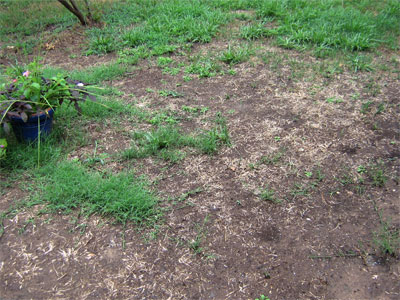
Answer: I can only speak from firsthand experience collected over 43 years of living in the same general area as you. I never could keep fescue going in our shaded areas. It was beautiful from planting in early fall all the way through early June, but I was left with the job to do over again by the following September. Plus, I had brown grass and bare ground all summer. Fescue is no more tolerant of shade than St. Augustine, and in our part of Texas, I think fescue is a lot more work. Buffalograss needs as much sun as bermuda, plus bermuda invades it. I am not a buffalograss advocate. (Also, to have addressed it: there are a couple of varieties of grasses that are claimed to grow in almost total shade. I have serious questions about the ads’ statements, and I do not accept the suppliers for advertising.) You ask for my opinion? In my own yard, without so much as a second guess, I have St. Augustine wherever it will grow and groundcovers like mondograss, liriope, purple wintercreeper euonymus and Asian jasmine elsewhere. I even have a few beds of attractive rounded river rock as groundcover.
Question: I have a large slope planted with Asian jasmine. Areas are dying out, and the problem is spreading. Could this be a fungus? H.D., Waco.
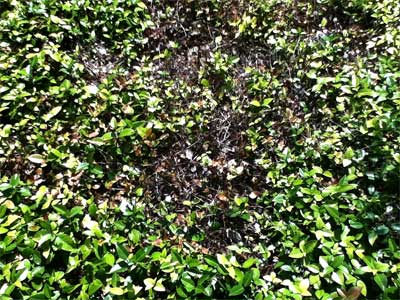
Answer: I guess it could, but I’ve never seen an insect or disease of any kind at any time hit Asian jasmine since I began growing it as a teenager in 1958. It may be the most bulletproof plant that I’ve ever grown. Freeze damage will burn it back, of course, but it comes right back – and this is not freeze damage. I’ve seen beds that look like this scores of times over the years, and it has always been due to water shortages. Check your sprinkler system, or try to cover the area more uniformly if you’re using a hose-end sprinkler. If I’ve missed the boat entirely, I’d suggest sending a sample to the Texas Plant Clinic (Plant Disease Diagnostic Laboratory) at Texas A&M. Hope this helps, though.
Question: What would have caused my 5-year-old Bradford pear to develop brown, crispy leaves? There have been no changes in the area. No name or city given.
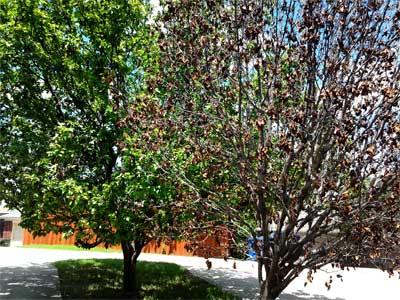
Answer: Oh, what I’d give if you had just told me where this tree is growing. Cotton root rot is almost assuredly involved, and it will probably spread to the adjacent pear in the next year or two (or sooner). It is a soil-borne fungus that waits for years in alkaline soils before it attacks established trees and shrubs. It impacts as many as 80 percent of our landscape species, although some are far more vulnerable than others. Pears and apples are top-of-the-list. I’d suggest ‘Little Gem’ southern magnolia as a resistant species to replace them. It grows to the same height (30 ft.) and width (20 ft.) and form, yet it’s far more dependable. It also doesn’t break in half after 10 or 12 years like the pears do. Hope that information helps.
Question: My Bradford pear has limp, black leaves at the ends of the branches. I’ve already lost another pear to the heat, and I don’t want to lose this one. It doesn’t seem to be spreading. S.K., Fort Worth.
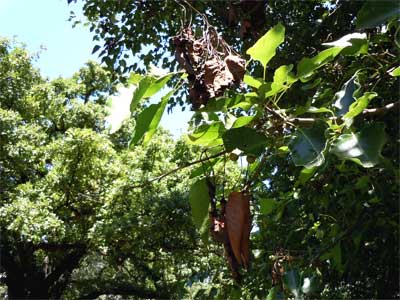
Answer: It’s wonderful that these two questions showed up back-to-back, since they show the two disease problems that Bradford pears encounter. This is fire blight. It is a bacterial infection that attacks the plants while they’re blooming. Personally, I had only seen it a time or two in the first 42 years of working in media horticulture. Then, in Spring 2012, it was EVERYwhere. Epidemic proportions. This year has been bad, but not that bad. It’s really odd that a plant that has been resistant suddenly succumbs. My guess is that there was a subtle shift in the genetics of the bacterium, and that Bradfords became more susceptible as a result. What to do: prune out the dead branches by cutting back 5 or 6 inches below the dieback. Dip and disinfect your pruning tools in a bucket that is 90 percent water and 10 percent chlorine bleach between cuts. You can also spray with agricultural streptomycin while the trees are in full flower, but that spray would be of no value now.
Question: What should we do with our blackjack oak tree? It has a thumb-sized hole at its base. Will it heal by itself? Should we have it removed? We’ve had conflicting suggestions. J.DLT., no city given.
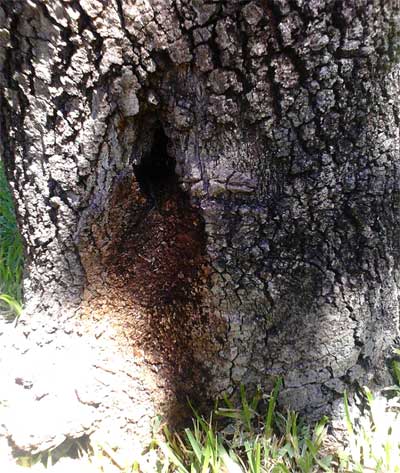
Answer: Don’t take it out yet. Trees generally can heal across a wound this small. Let the top growth be your additional guide. If the tree is growing actively, and if new bark is forming across the opening, then you should be fine. Let a certified arborist watch it with you for the next couple of years.
Question: I’m planning on building a tree house in this large pecan. There is an area in the lowest crotch where water collects. Should I put concrete in to seal it, or perhaps drill a drainage hole? Any suggestions? D., no city given.
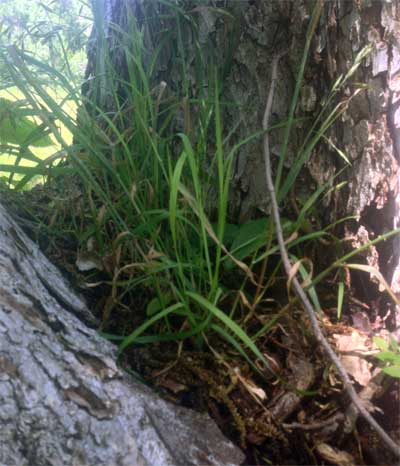
Answer: Don’t put any concrete into the tree. Trees wall off against moisture. I would start by washing the soil and vegetation out of the cavity so you can see what is truly going on there. Best advice: have a certified arborist help you with the tree. First-hand suggestion: build a free-standing tree house right alongside the tree, perhaps 12 inches away from it. If you want kids to be able to climb the trunk, position the house in a way that they can catch on. Don’t nestle it within the branches, because branches grow thicker, and that can ruin a tree house built between them. They also flex in the wind (going different directions), and that can be rough on construction. I had a tree house for our kids, and it lasted only five or six years due to those same issues.
Question: I’ve attached a photo of one of my jalapeno plants. I’ve added calcium and magnesium, and I’m thinking it might be tobacco mosaic virus. This is the second year they have done this. What can I do? Name not given, Alvarado.
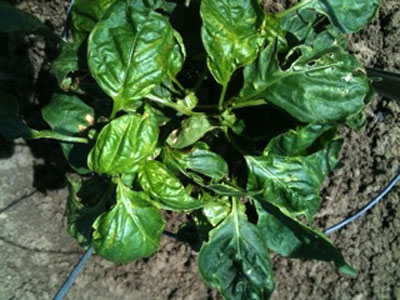
Answer: This looks like damage of thrips. Try one of the products labeled for use on vegetables, perhaps one of the Spinosad insecticides.
Question: Last spring I planted a bed of Chocolate Chip ajuga. It did well all year, but this year whole sections of it are dying out. It starts in the center of the plant and spreads out. Is it water-related? R. and D. A., no city given.
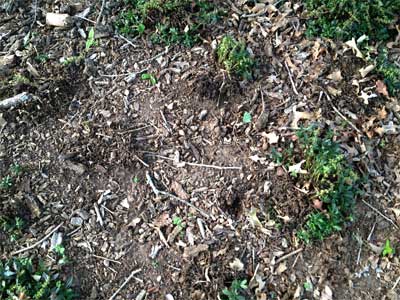
Answer: Funny you’d ask. I looked in on a friend’s plantings a week ago, and he was having the very same problem with the very same variety. And I did, too, probably 30 years ago – but with two other varieties. As I told my friend, this is a serious soil-borne fungus called southern blight, and it washes through beds of ajuga like a weather front coming over a town. I lost several hundred plants in a matter of days back in the 1980s, and I’ve never replanted big areas to the plant. I love its look, and I do plant it among landscaping rocks on slopes and other well-draining spots, but I don’t use it as a mass groundcover. Here is the info from TAMU:
http://plantdiseasehandbook.tamu.edu/landscaping/ground-covers/ajuga/
Question: Our live oak tree just doesn’t look healthy. It is a light green compared to the deep dark green of the other live oaks on the street. Shall we assume that something besides the galls is causing the sickly color? A different variety of oak? Perhaps the previous owner didn’t water enough or watered too much? P., no city given.
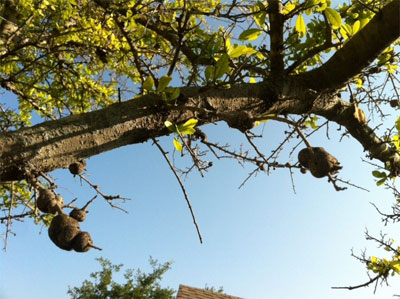
Answer: The galls did not cause the tree to turn yellow. It’s in serious need of nitrogen. If there are iron deficiency issues as well, they would be due to some type of injury to the trunk or roots. I’d suggest getting a certified arborist out to be sure there isn’t an inherent disease or some type of decay going on somewhere that I can’t see in the photos. (By the way, thanks for your comments about listening to me for all those years. I hope you know that I changed stations three years ago — I’m now on WBAP Sunday mornings 8-10. 820AM and 96.7FM. Tune us in!)
Question: I resodded a part of our yard two years ago with St. Augustine. This weed has moved into both the bermuda and the St. Augustine. It seems to be taking over. Someone suggested vinegar, but it didn’t work. What will kill it? J.F., Richardson.
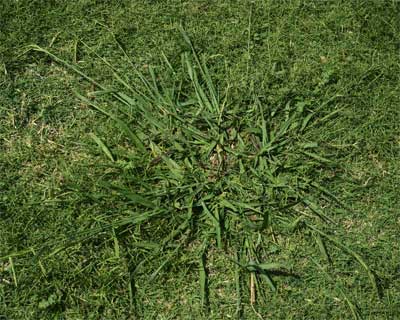
Answer: This is dallisgrass, and it is one of two really difficult weeds to eliminate. Vinegar on it would be, in my terms, a joke. Since we no longer have MSMA, you’re either going to have to spot-treat it with a glyphosate-only herbicide, or you’ll have to dig it out with a sharpshooter spade. Either will leave a dead spot in your lawn, but the grass will grow right back over the void. Someone suggested on my Facebook page that they cut the big end out of a one-gallon plastic milk bottle, then place the bottle over the clump. They then insert the spray wand with the glyphosate herbicide down into the bottle and spray to coat the weed’s leaves. The bottle prevents any drift. You need to take action soon, because all seeds of dallisgrass can germinate. Don’t waste any time!
Question: What would cause the roots of my cantaloupes to be so disfigured? Green bean roots had the same issue. What can stop this? K., San Antonio.
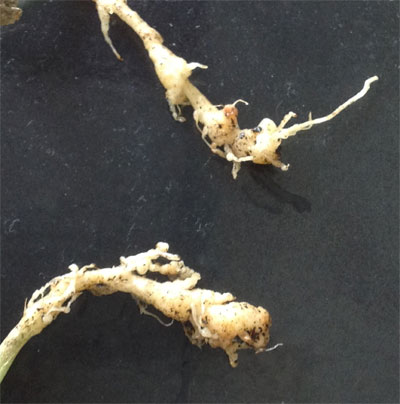
Answer: These are root knot nematodes. The microscopic soil-borne worms sting the plants’ roots and inject digestive fluids into their tissues. The galls are the resulting growth produced by the plants. Steps to deal with them, since there is no soil treatment to eliminate them: start with nematode-resistant types of vegetables. Cool-season crops are far less affected. Some varieties of tomatoes, as another option, are nematode-resistant, and that should be noted on the plants’ pot labels and in their descriptions in seed catalogs. Plant Elbon cereal rye in the garden as a winter “cover crop” this October. Plow it under by mid-January, and it will have entrapped many of the nematodes in its root systems. Consider moving plantings of susceptible varieties to new soil elsewhere in your yard. Grow some of the most important crops, tomatoes as the classic example, in pots filled with potting soil that contains none of your local topsoil.
Question: I’m wondering if I have St. Augustine decline. My Palmetto St. Augustine has been going downhill for several months. I’m getting all kinds of answers. I hope the photos will help with a more accurate diagnosis. Some of the affected grass is now in full sun. S.McL., Conroe.
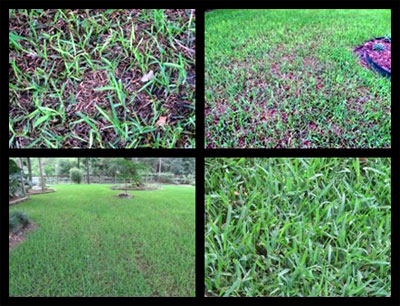
Answer: Unfortunately, the photos are all small thumbnails, and it was difficult for me to see them in any detail. It looks like there might be a great deal of shade involved in some of the areas, and that can take St. Augustine down. It is not St. Augustine decline, but it could be Take All Root Rot, since you took the photos a couple of weeks ago before it turned hot. Please forgive me, but I can’t get any closer. Please let me send you to my website, to the Most Asked lawn questions. Scroll down toward the bottom to see St. Augustine. http://www.neilsperry.com/maq/lawns/ You could also look at “St. Augustine diagnostics” in my “Notes” section on my Facebook page. It covers just about everything.
Question: What should I do with my bluebonnet seeds now that they’re dry? I want them to come back next year. N., San Antonio.
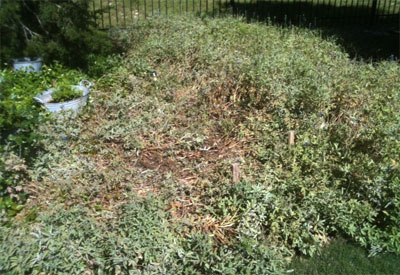
Answer: You can mow the area as soon as they are completely dry (now). They will lie dormant over the balance of the summer, then they will begin to germinate in late September, as cooler weather and moisture begin to return to Texas. (I’m ready already.)
Question: I have two Big Boy tomato plants growing in large pots. About half of the tomatoes are rotting on the bottoms, and the plants are turning yellow. What can I do? R.L., College Station.
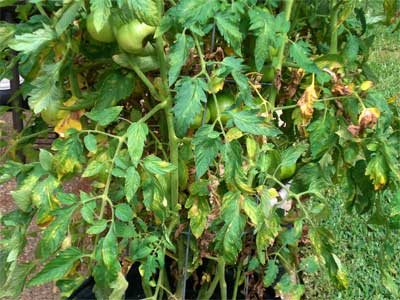
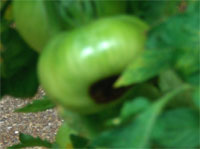 Answer: Blossom-end rot is caused by extremes in moisture. It’s most common in container tomato plantings, because there is more limited root area, and it happens when the plants get too dry. The ends of the fruit are the points farthest from the roots. Aim to keep the plants moist at all times. The yellowing is due to early blight (shows up in May) and spider mites (show up in late May where you are and early June farther north). Your nurseryman can show you the control options, but it’s way too late for Big Boy for this year. Large-fruiting tomatoes are ultimately frustrating in Texas. They fail to set fruit once it gets hot. You always want to grow small and mid-sized varieties.
Answer: Blossom-end rot is caused by extremes in moisture. It’s most common in container tomato plantings, because there is more limited root area, and it happens when the plants get too dry. The ends of the fruit are the points farthest from the roots. Aim to keep the plants moist at all times. The yellowing is due to early blight (shows up in May) and spider mites (show up in late May where you are and early June farther north). Your nurseryman can show you the control options, but it’s way too late for Big Boy for this year. Large-fruiting tomatoes are ultimately frustrating in Texas. They fail to set fruit once it gets hot. You always want to grow small and mid-sized varieties.
Question: Can this crape myrtle be pruned into tree-form instead of as a shrub? If so, when? C.C., no city given.
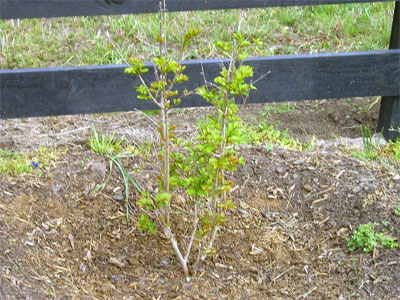
Answer: Absolutely! That’s how all tree-form crape myrtles got their starts. However, you need a lot more vigorous growth before you’ll be ready to try this. Apply nitrogen food to it this growing season and keep it moist at all times. You’ll be ready to start training it tree-form in a year or two.
Question: I’m not sure what is hitting the trunk of my oak tree. Photo was taken as the leaves were coming in. You can see the ashen-looking area on the trunk. It breaks off easily. What should I do? We are protecting the trunk from construction traffic. S.R., Argyle.
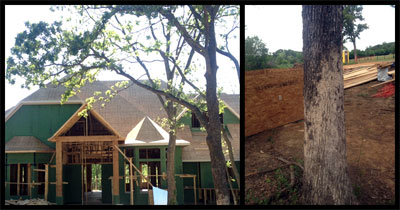
Answer: You need to get a certified arborist on-site immediately to help you protect your trees. I can’t tell if this is Hypoxylon canker, but that would be one possibility. It may be nothing. Someone needs to probe a lot deeper than I’m able to do from photos. Post oaks are notoriously unforgiving when we start doing things around them. If you don’t have an arborist already on call, I’d suggest Arborilogical Services, www.arborilogical.com. Steve Houser and Bill Seaman, who write for us here, are both with that fine firm.
Question: What is wrong with my magnolia? This is affecting about 5 percent of the leaves. D.W., no city given.
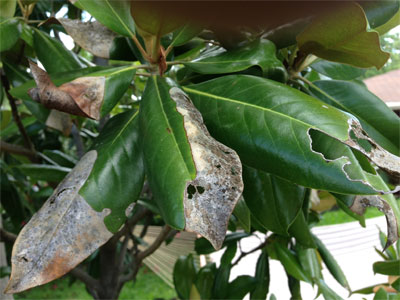
Answer: This is absolutely normal for magnolias. Every May and June, they shed tons of leaves – in fact, it’s the changeover from last year’s old, beaten leaves to the new year’s new growth. No cause for concern whatsoever.
Question: Why would large pieces of bark be missing from my mature Shumard red oak? There are no leaves at the end of this branch. What should I do? K.Y., Richardson.
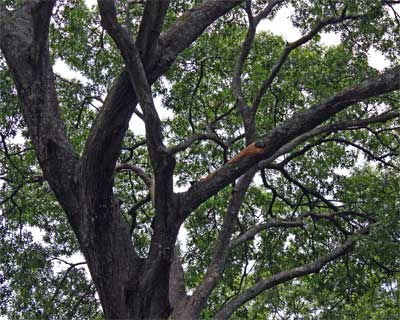
Answer: This is either Hypoxylon canker (my guess) or possible damage by squirrels. I do see additional bark splitting along the undersides of a couple of other branches. When bark is lost all the way around a tree’s trunk or branch, it will cause the leaves beyond that point to die. Get a certified arborist on site to look at it. Again, as I replied to an earlier post, Arborilogical Services, www.arborilogical.com, is in your neighborhood.
Question: My lawn has looked like this the last couple of springs. I think thatch may be preventing bermuda to root and grow. I used a regular garden rake. Is it time to rent a power dethatcher? M.S., Rowlett.
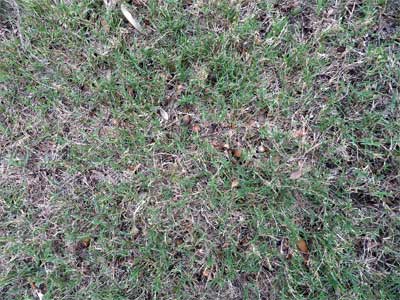
Answer: I would try scalping the lawn by dropping the mower one notch. Hopefully that will take you back down to maybe 1-1/2 inches. Then check to see if there is, indeed, actual thatch. It will be compacted grass clippings and other organic debris that is (a) beneath the runners and (b) mat-like, enough so that you could dig it out and hold it out like a piece of cardboard. If you find something akin to that, I would rent an aerator that pulls plugs out of the thatch layer and throws them out on top of the soil. That ensures that air, water and nutrients can get into the root zone. If you do not find a thatch layer after you scalp, I’d suggest making a one-time application of 21-0-0 to boost the grass into rapid green growth.
Question: We moved into a new home last July and had four live oaks planted. They now have splitting bark. Is this anything we should be worried about? E.H., no city given.
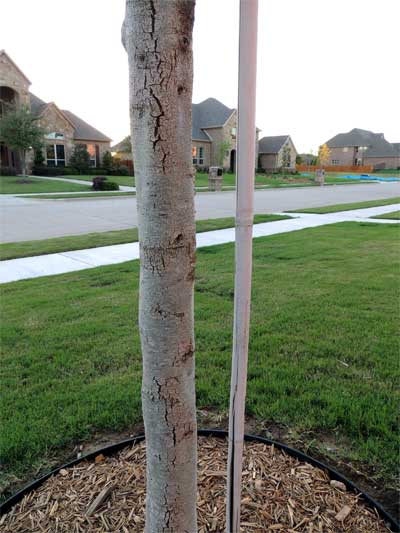
Answer: This is sunscald, and yes, you do need to worry about it. I would suggest that you apply paper tree wrap from the ground up to the lowest branches on each tree. Hopefully you’ll be able to stop further damage. This happens because the trees were suddenly planted out in the open, where they had been growing side-by-side and shading one another in the nursery before. The paper tree wrap is pretty much non-negotiable, as far as I’m concerned, with all oaks and Chinese pistachios.
